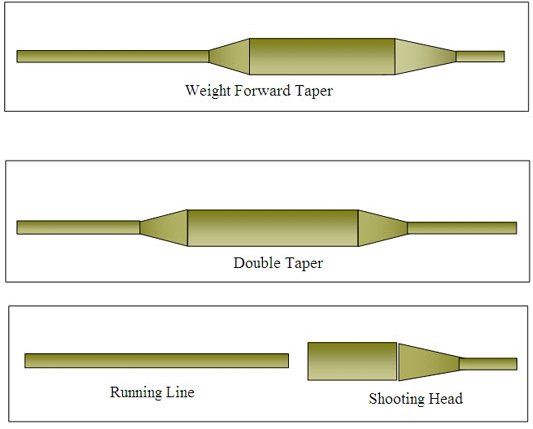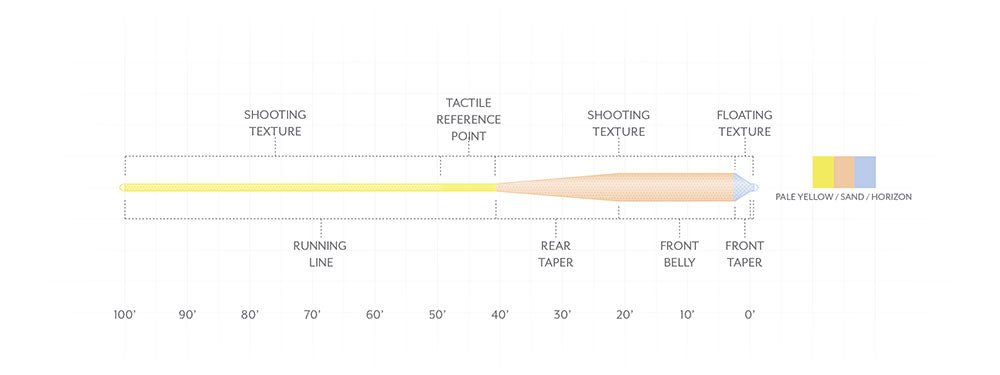Fly Lines, which one?
Fly lines have come a long way since the days of silk fly lines that required constant maintenance. The styles of fly lines available have now changed tremendously and there isn’t a fly line situation that doesn’t have a fly line designed to deal with it.
The first thing to consider is the weight of the fly line which is the nuts and bolts of casting, essentially the unloading of energy stored in a bent rod and then transmitted through the line. As a result fly lines are tapered to smooth this transmission of energy from rod to line. Energy transfers easily from thick to thin sections of line, hence the fly line is at its thinnest at the tip, where you attach the tippet to, it then tapers back into a fatter section or ‘head’.
The head contains the weight that the rod needs to bend; the more of the head you have outside the rod tip the more weight the rod pulls against in the cast. The more weight that is pulled the more bend you get in the rod, the more bend (load) you get in the rod the further the line will cast.
These weights are traditionally measured over the first 30 ft of a fly line and conform to the AFTMA system (Association of Fishing Tackle Manufacturers Association). As a result every line from every manufacturer of a specified weight should weigh the same within a tolerance so regardless of the line bought the line should work the rod in the same way, or so you would think! In reality certain line and tapers work best with particular rod actions. This is why the Boss Outdoor pro’s work hard to try and match tackle for customers to suit their rods and casting style preferences.
The type of fly line can affect the performance of the rod tremendously. The basic taper types are weight forward double-taper, and shooting head.
Weight Forward
Are used by the vast majority of fly fishers. They consists of a head (traditionally 30ft) which is all the line you need outside the rod tip to load the rod. This then tapers back into a very thin running line which when released in the cast offers little resistance to the rod rings and is basically towed out by the head when the cast is released. As a result distance fishing becomes very easy as you don’t need to cast lots of running line, you need only to cast the weight forward part or have the weight forward part beyond the tip of the rod.
Scientific Angler - Amplitude Smooth Infinity Taper.
Double Taper
As the name suggests, are tapered at the front and at the back in between the two tapers is a continuous thickness of line which is relatively ‘fat’. This fatter line holds the weight that the rod needs to load. They are great for controlling a lot of line out (mending) or when you are primarily nymphing, Double Taper’s make a great all-around line for a wading fisherman who fishes smaller and medium sized streams, they don’t shoot long distances as well because of the fatter diameter in the back of the line.
Shooting Head
These were developed in the 1970’s by distance casters. They are attached to a very thin running line or nylon monofilament and allow extreme distances to be achieved. The downside is that the thin running line is prone to tangling in windy conditions and if nylon is used then spool memory also becomes an issue increasing the propensity for the line to tangle. Today they are used very little with single handed rods but with increasing frequency with double–handed rods.
What weight do I need?
All fly rods manufactured have some information on the butt section near the handle that tells you the weight of line required to load or bend the rod to its optimum. If there is one number only it relates to a weight forward line. If there are two the smaller is the double taper weight and the larger relates to the weight forward equivalent. If there are three then the lowest is the double taper the middle the weight forward and the largest is the shooting head weight.
The development of modern fly rods (which are faster in action than their predecessors) has made the AFTMA system slightly inaccurate. Manufacturers are just squeezing the tolerances a little to allow deeper loading of these faster rods. Manufacturers have specialist lines designed for these faster action rods which are really half an AFTMA size heavier, so a 6wt line is really a 6.5 and allows these rods to load a bit deeper generating more distance.
Also a big problem with a lot of casters is the amount of running line that is out prior to casting. Only the head really needs to be cast, many fishers try to hold too much line in the air resulting in a lot of running line outside the rod tip. This running line has a different density to the weight forward element and as a result it moves through the air at a different speed. This promotes hinging, which causes slack line in the cast and a loss of power through the casting stroke. To combat this manufacturers now produce two tone lines where the head and running line are different colours. This gives a clear visual indicator as to exactly where the weight element ends.
Scientific Angler - Amplitude Smooth Trout Taper.
Weight forward lines are also varied in their head lengths there are short headed versions of fly lines so less line is needed in the air to load the rod. These shorter headed lines have the same weight as a standard 30ft head but they are effectively heavier for their length so have more mass. They are ideal where back casts are restricted but because they have more mass load a rod deeper and generate more speed so are very effective for turning over bigger flies and are more effective at combating wind.
Scientific Angler - Amplitude Grand Slam Taper.
If you still need help, give the professional staff at Boss Outdoors a call (click here).



